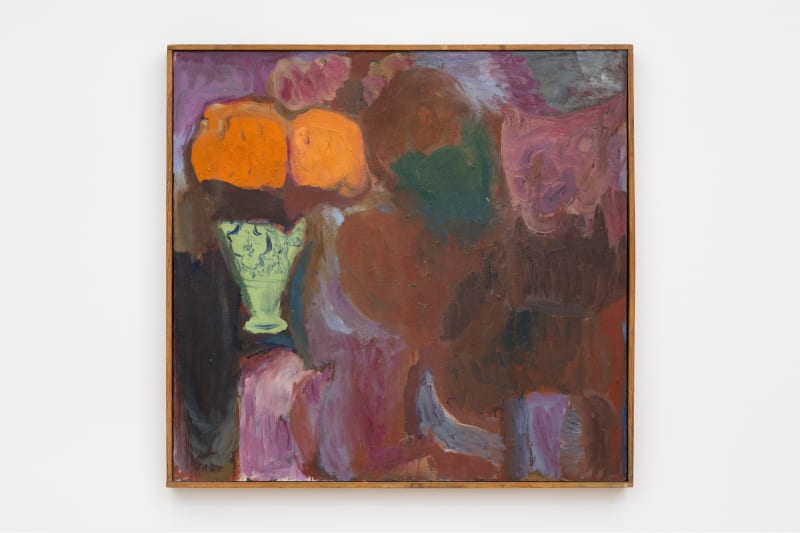Carole Gibbons (b. 1935 Glasgow, Scotland) studied at Glasgow School of Art and was a member of The Young Glasgow Group alongside her peers Alan Fletcher and Douglas Abercrombie. After her studies she travelled to Europe, living in Spain for a time which deeply impacted her work. She lives and works in Glasgow.
For over six decades, Gibbons has cultivated a distinctive painting practice rich with resonant colour and symbolism in a striking painterly language. She received early career success between the 1960s-1980s and was the first living woman to have a solo exhibition at Glasgow's Third Eye Centre in 1975. However, it has not been until recently that Gibbons has gained more widespread recognition. She has long been championed by artists Lucy Stein, Andrew Cranston, poet JF Hendry, writer Alasdair Gray, and art historian Susannah Thompson.
Gibbons' paintings encompass many subjects including folkloric landscapes, existential portraits, ever-present cats and charged still lifes, which are worked on over months and years. A great colourist - 'her still lifes mostly painted in Glasgow, are strong but melancholy harmonies where rich colours - sometimes surprisingly sweet - glow among sombre ones.'[1] Gibbons' paintings have their own 'logic' and 'atmosphere'[2]within formal explorations of colour, surface and uncanny pictorial organisation. Motifs are repeated in the works - a Moroccan vase, a Chinese horse figurine, a scallop shell and stone heads. These long-treasured objects are not only used as a compositional tool but are imbued with psychological fervour. In dreamlike visions there is a synthesis of subconscious and fantasy with the material world.
From an early age Gibbons has been fascinated by mythology, drawing upon themes throughout her paintings and drawings. Evacuated to the Highlands in 1941, her mother sent books on Greek myths which were formative to her being. The mythological fed into important early landscape works such as Mary Queen of Scots (1966) as well as portraits, such as Elegy (1967) - a portrait of her mother as a Goddess figure. In early works Gibbons connected to the concept of stream of consciousness and the writings of James Joyce. Later, domestic scenes and interiors still weave in the epic through the staging of meaningful objects, sculptures, and referential books. Art historical references and classic painterly themes are combined with Gibbons lived experience in deeply personal paintings.
Gibbons’ works are held in collections across the United Kingdom, in the National Galleries of Scotland, Edinburgh; City Art Centre, Edinburgh; Glasgow Museums; Inverness Museum and Art Gallery; Hunterian Art Gallery, Glasgow; Aberdeen Art Gallery; Low Parks Museum, Hamilton; The Argyll Collection, Oban; Leeds Museums and Galleries.
Gibbons' first exhibition in the US opened at White Columns in 2024. She has also been included in exhibitions at Tate Britain, London (2024); Traverse Theatre, Edinburgh 1968; Compass Gallery, Glasgow (1970); Aberdeen Art Gallery (1972): North Briton Gallery, Gartocharn (1973); Commonwealth Institute, Edinburgh (1973); Third Eye Centre, Glasgow (1975); Edinburgh College of Art (1978); Leeds Gallery (1979); and 369 Gallery, Edinburgh (1980). In 2012 Lucy Stein staged two exhibitions including Gibbons, a group show, Strohwitwe, Glasgow and Lucy Stein: Manderley with Carole Gibbons: Paintings and Drawings at Gimpel Fils, London. Gibbon's work has been included in survey shows, Studio 58: Women Artists in Glasgow since WW2, Glasgow School Art; 369 Remembered - The Women, Summerhall, Edinburgh (2018); Against All Odds, Beyond Borders, Traquair House (2021); From The Studio, House for an Art Lover, Glasgow, 2021; I Suppose In A Dream, Kupfer Gallery, London 2022, Obscura Luz, Galeria Luisa Strina, Sao Paulo, 2022.
In 2023, Gibbons first monograph was published by 5b.
